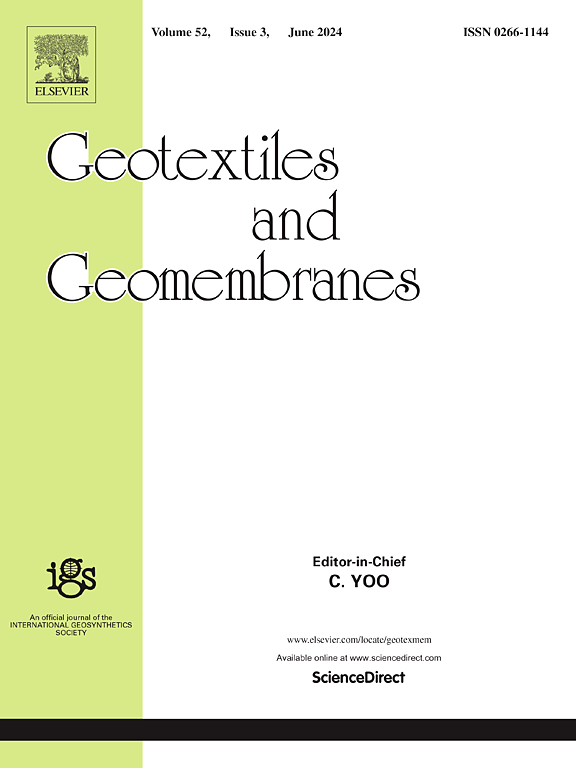回填表面沉降槽对垃圾覆盖层渗漏的影响
IF 4.7
1区 工程技术
Q1 ENGINEERING, GEOLOGICAL
引用次数: 0
摘要
通过实验和数值计算探讨了回填表面差异沉降槽以减少渗漏的效果。现场实验检查了两个内衬区段,每个区段的内衬上都有一个直径为 11 毫米的孔,垂直坡度名义上为 4 水平:1。在一个 2 米乘 3 米、深 0.3 米的凹陷处,冬季用 50-50 的沙雪混合物填充,以形成 4H:1V 的连续斜坡,然后覆盖衬垫和 0.3 米的覆盖土。春季解冻后产生了一个深达 0.14 米的差异沉降槽。第二段类似的沉降槽用覆盖土回填,以恢复 4H:1V 的表面,而衬垫中的沉降凹陷仍然存在。在 15 个月的监测中,回填后的渗漏量减少了 57%,从每年的 565 升减少到 244 升(即在寒冷季节减少 60%,从 351.3 升减少到 137.8 升,在温暖季节减少 45%,从 141.8 升减少到 77.6 升)。三维数值模型与实验结果的一致性令人鼓舞。该模型表明,渗漏与坡度之间存在反比关系,渗漏与洼地深度和洼地上游距离之间存在直接关系。覆盖层水导率的影响很复杂。本文章由计算机程序翻译,如有差异,请以英文原文为准。
Effect of backfilling surface settlement trough on waste cover leakage
The effect of backfilling of a surface differential settlement trough to reduce leakage is explored both experimentally and numerically. The field experiment examined two lined sections each with an 11 mm-diameter hole in the liner on a nominally 4 horizontal:1 vertical slope. A 2 m by 3 m, 0.3 m deep depression was filled with a 50-50 sand-snow mixture in winter to give a continuous 4H:1V slope prior to covering with the liner and 0.3 m of cover soil. Spring thaw induced a differential settlement trough up to 0.14 m deep. A second section with a similar trough was backfilled with cover soil to reinstate the 4H:1V surface while the settlement depression in the liner remained. Over the 15 months of monitoring, the backfilling reduced leakage by 57% from a annual total of 565 L to 244 L (i.e., a 60% reduction in colder seasons, from 351.3 L to 137.8 L together with a 45% reduction in warmer seasons, from 141.8 L to 77.6 L). A 3D numerical model showed encouraging agreement with the experimental results. The model indicated an inverse relationship between leakage and slope gradient, and a direct relationship between leakage and depression depth and upgradient distance to the depression. The effect of cover hydraulic conductivity was complex.
求助全文
通过发布文献求助,成功后即可免费获取论文全文。
去求助
来源期刊

Geotextiles and Geomembranes
地学-地球科学综合
CiteScore
9.50
自引率
21.20%
发文量
111
审稿时长
59 days
期刊介绍:
The range of products and their applications has expanded rapidly over the last decade with geotextiles and geomembranes being specified world wide. This rapid growth is paralleled by a virtual explosion of technology. Current reference books and even manufacturers' sponsored publications tend to date very quickly and the need for a vehicle to bring together and discuss the growing body of technology now available has become evident.
Geotextiles and Geomembranes fills this need and provides a forum for the dissemination of information amongst research workers, designers, users and manufacturers. By providing a growing fund of information the journal increases general awareness, prompts further research and assists in the establishment of international codes and regulations.
 求助内容:
求助内容: 应助结果提醒方式:
应助结果提醒方式:


